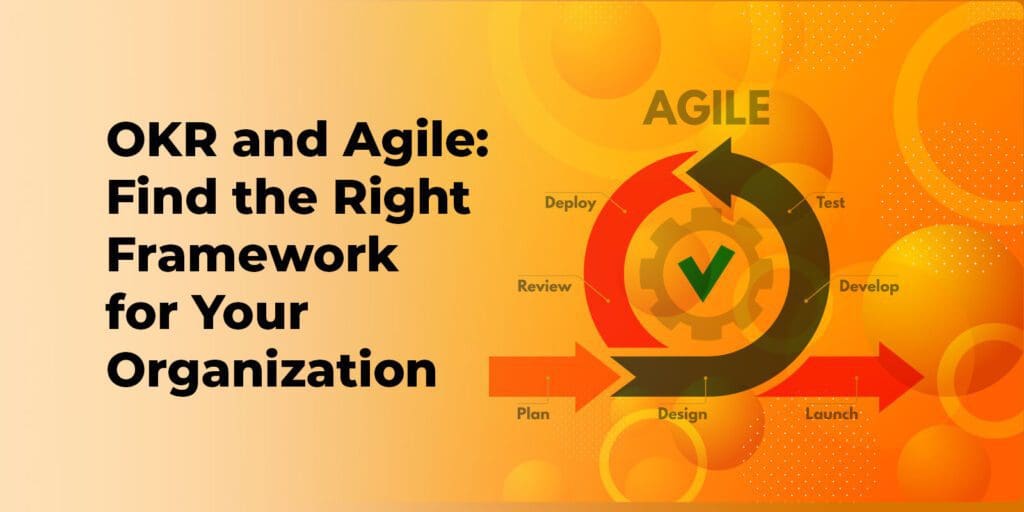Table of Contents
OKR and Agile: Find the Right Framework for Your Organization
Project management is critical to any organisation’s success, ensuring that projects are delivered on time, within budget, and to the expected quality standards. However, poor project management can lead to significant resource waste, impacting an organisation’s bottom line.
According to recent research, organisations waste around 12% of their valuable resources due to poor project management. This includes wasted time, money, and effort, which could have been better utilised for other important business activities.
Adopting Agile methodologies and OKR frameworks can help organisations improve their project management practices, mitigate waste, and improve overall efficiency.
In this blog, we will explore OKR and Agile frameworks and discuss how they can be used together to help teams achieve their objectives.
Whether you are new to OKR and Agile or looking to refine your existing processes, this blog will provide valuable insights and practical advice to help you improve your project management practices and achieve your objectives more effectively.
Can Agile & OKR be used together?
Agile and OKR methodologies are increasingly being combined by organisations to enhance their performance and achieve goals more efficiently. This integration enables companies to set clear objectives and measurable results to track progress while utilising the flexibility and adaptability of Agile for desired outcomes.
Consequently, teams can stay focused on their goals and continually improve their processes through iteration. Many top brands like Google, LinkedIn, Amazon, and Adobe have adopted this approach and successfully leveraged both frameworks to achieve their objectives.
What are OKRs?
OKR (Objectives and Key Results) is a goal-setting framework that helps organisations align individual and team efforts with strategic objectives.
The framework consists of two parts:
Objectives
The goals that an individual or team wants to achieve
Key results
The metrics used to measure progress towards those goals


OKRs are typically set every quarter, with regular check-ins and progress updates. The framework is designed to encourage focus, alignment, and transparency and to help individuals and teams prioritise their work and track progress towards their goals.
Evolution of OKR
The OKR framework has evolved over time, adapting to business practices and technology changes. Here’s a brief overview of the evolution of OKR
Early Development:
OKRs were first developed in the late 1970s by Andy Grove, former CEO of Intel. He created the framework as a way to align the goals of individuals and teams with the company’s overall objectives.
Adoption by Technology Companies:
In the early 2000s, technology companies like Google and LinkedIn adopted OKRs and made them popular.
Expansion to Other Industries:
Over time, OKRs have expanded to other industries outside of technology. Many companies in retail, finance and healthcare have also adopted OKRs.
Integration with Agile Methodology:
In recent years, OKRs have been integrated with Agile methodology, which focuses on delivering products and services quickly and efficiently through iterative development cycles.
Emphasis on Continuous Improvement:
Today, OKRs emphasise the importance of continuous improvement and learning. Companies use OKRs not just to set goals and evaluate progress learn from successes and failures, and adjust their strategies accordingly.
What is the Primary Purpose of OKRs?
The primary purpose of OKRs (Objectives and Key Results) is to provide a framework for setting and achieving goals. More specifically, OKRs can serve several purposes, including:
- Aligning individuals and teams around shared goals.
- Employee Engagement
- Prioritising work and focusing efforts.
- Driving accountability and ownership.
- Encouraging continuous improvement.
What is Agile?
Agile is a project management approach that emphasises flexibility, collaboration, and continuous improvement. The Agile methodology was first developed in the software development industry as an alternative to traditional, rigid project management methods.
What are the Key components of Agile?
Agile typically involves breaking a project into smaller, manageable pieces called sprints. Each sprint is normally 1-4 weeks long and involves a cross-functional team working together to deliver a small set of features or improvements. At the end of each sprint, the team reviews and reflects on their progress and adjusts their plans for the next sprint.
Agile is often used in software development but can also be applied to other industries and projects. The approach emphasises flexibility and collaboration, allowing teams to respond quickly to changes in requirements or market conditions and deliver high-quality results more efficiently.
What Are The Benefits Of Agile?
- Customer satisfaction through continuous delivery of working software.
- Embracing change and adapting to new requirements throughout the project.
- Working collaboratively with stakeholders, including customers and team members.
- Delivering frequent, small iterations of the project to improve and provide value continuously
- Empowering teams to self-organize and make decisions together.
- What is the difference between Agile and OKR?
- Here are 6 key differences between Agile and OKR
Purpose
Agile is a project management methodology that emphasises iterative development and continuous delivery. At the same time, OKR is a framework for defining and tracking objectives and outcomes that align with an organisation’s strategic goals.
Focus
Agile focuses on delivering high-quality products or services that meet the needs of customers or stakeholders. In contrast, OKR focuses on achieving strategic goals and objectives aligned with an organisation’s vision and mission.
Approach
Agile emphasises breaking down work into small, manageable pieces and prioritises collaboration and continuous feedback, while OKR emphasises setting measurable objectives and prioritises transparency and accountability.
Timeframe
Agile operates on a shorter time frame, usually in sprints of 1-4 weeks, while OKR operates on a longer time frame, typically quarterly or annually.
Team Structure
Agile teams are usually cross-functional and self-organising, while OKR teams may be more departmental or hierarchical.
Implementation
Agile is implemented through methodologies such as Scrum, Kanban, or Lean. In contrast, OKR is implemented through a structured framework that includes setting objectives, defining key results, and tracking progress towards those results.
Similarities between OKR and Agile
- Both OKR and Agile methodologies focus on continuous improvement and learning.
- Both methodologies place a strong emphasis on communication and collaboration.
- Both OKR and Agile are flexible and adaptable methodologies.
- Both OKR and Agile place a strong emphasis on transparency and visibility.
- Both methodologies emphasise accountability at the individual and team levels.
- Both OKR and Agile methodologies are aligned with strategic objectives.
Benefits of Using Agile and OKR together
Combining OKR and Agile can create a culture of continuous improvement and learning. Both methodologies emphasise the importance of learning from successes and failures, which can help organisations to innovate and improve over time.


Here are six benefits of using OKR and Agile together
Better Alignment:
Combining OKR and Agile methodologies helps to align the efforts of teams and individuals with the organisation’s strategic goals. OKR ensures that teams are working towards specific, measurable objectives that are aligned with the organisation’s overall strategy, while Agile helps teams to deliver high-quality products or services that meet the needs of customers or stakeholders.
Increased Productivity:
By combining OKR and Agile, organisations can create a continuous improvement and learning culture. Agile helps teams to work more efficiently and deliver value more quickly, while OKR provides a framework for measuring progress towards objectives and identifying areas for improvement.
Improved Communication:
Agile and OKR emphasise the importance of communication and collaboration within teams and across departments. Combining these methodologies helps ensure that everyone is working towards the same goals and clearly understands how their work contributes to the organisation’s overall success.
Greater Flexibility:
Agile and OKR are designed to be flexible and adaptable to changing circumstances. By combining these methodologies, organisations can respond quickly to changes in the business environment or customer needs.
Enhanced Transparency:
OKR and Agile both emphasise transparency and visibility. By using these methodologies together, organisations can track progress towards objectives, identify obstacles, and make data-driven decisions.
Increased Accountability:
OKR and Agile prioritise accountability at the individual and team levels. By combining these methodologies, organisations can ensure that everyone is working towards specific objectives and is held accountable for their performance.
Importance of selecting the right methodology for your organisation
Selecting the right method is crucial for the success of any organisation. Different methods suit different companies, depending on their industry, size, and culture.
Assessing your organisation’s needs, goals, and resources is important before selecting a methodology. OKR and Agile are not mutually exclusive and can be used together, but evaluating which method will work best for your organisation’s specific needs is essential.
Final thoughts
In conclusion, selecting the right methodology for your organisation is critical to achieving success. OKR and Agile are two popular methodologies that have proven to be effective for many companies, and they can also be used together to maximise their benefits.
However, it’s important to remember that every methodology is flawed and that what works for one organisation may not work for another. It’s essential to evaluate your organisation’s needs and select the best method with your goals and resources.
Regular evaluation and adjustment of your methodology are also crucial to ensure continued success.



